The ASUS Zenbook UX305 Review
by Brett Howse on March 25, 2015 8:00 AM ESTGPU Performance
On the GPU side, the Core M-5Y10 has the Intel HD 5300 Gen8 graphics of Broadwell, but with clock speeds of 100 Mhz to 800 Mhz, as compared to the 5Y71 which has 300MHz to 900 MHz available. We have tested several Broadwell processors so far, and the Gen8 graphics are a reasonable boost over the Haswell Gen 7.5 model, with a bump in execution units (EU) from 20 on Haswell to 24 on Broadwell. The Yoga 3 Pro has the Core M 5Y71, which on paper should offer more performance than the 5Y10 based UX305 that we received for review.
One thing that became clear on the Yoga 3 Pro review was how even though the GPU was the same number of EUs as the Broadwell-U processors, and it has the same base and boost clock speed, the 4.5 watt window of Core M limited performance quite a bit. As we saw on the system performance already though, ASUS has elected to allow Core M to get hotter, so that may change the outcome on the GPU as well.
FutureMark 3DMark

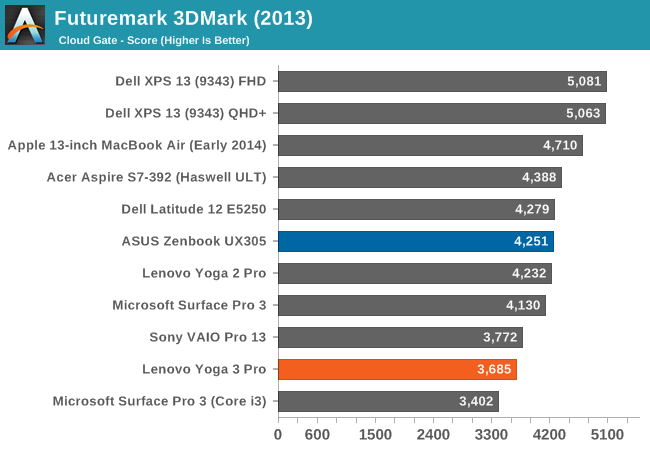
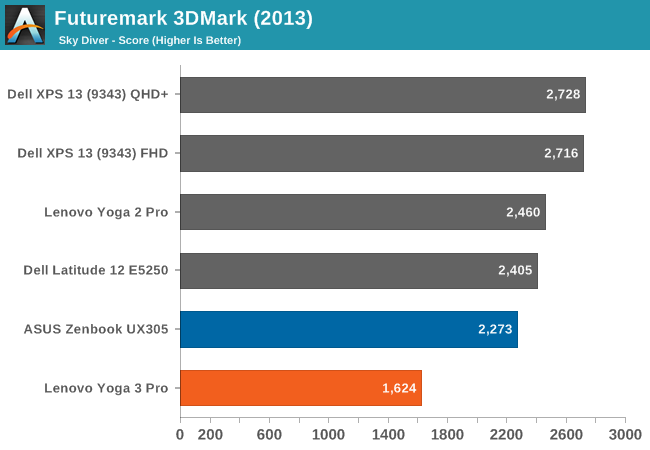

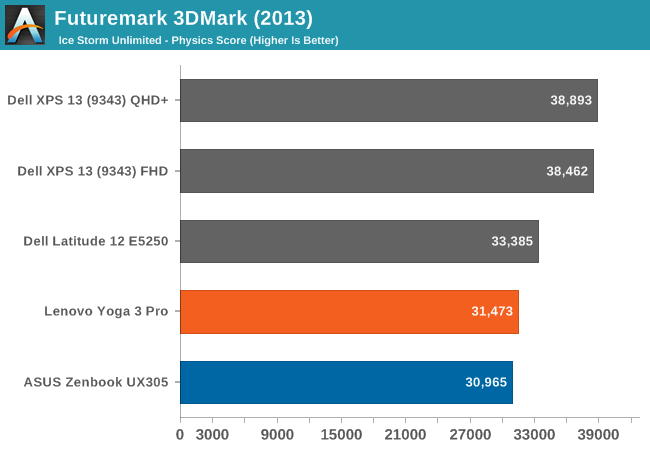
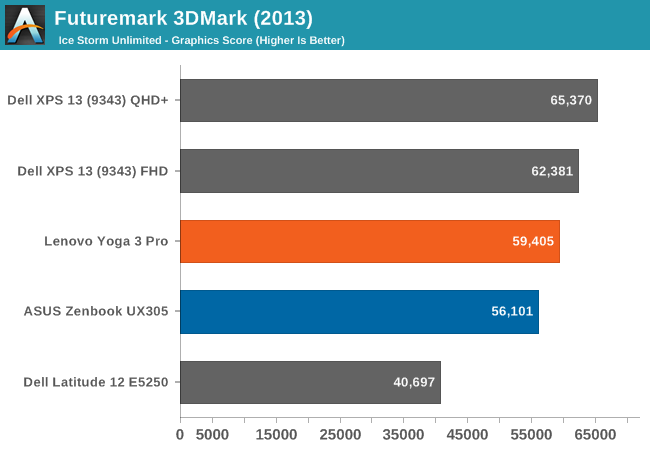
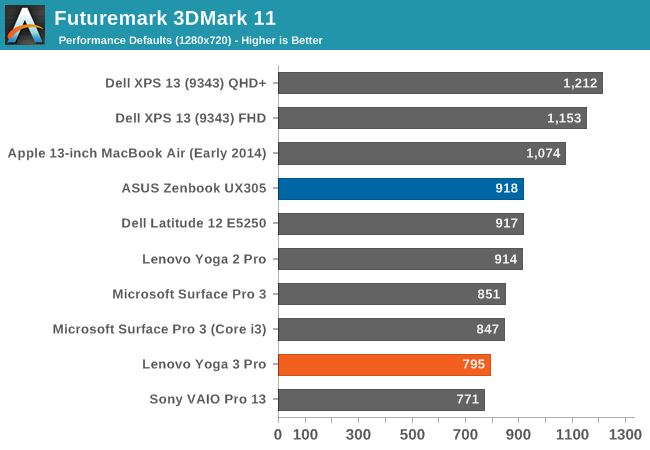
FutureMark has compiled several benchmarks in 3DMark 2013. All are a reasonable length, except for Ice Storm Unlimited which is more of a smartphone/tablet benchmark, and therefore completes very quickly on a PC. Here we can see how much more performance the ASUS UX305 can deliver over the Yoga 3 Pro, which again on paper has a faster processor. ASUS allows much more thermal headroom on the SoC, which results in considerably better scores when using the GPU. The exception to this is the Ice Storm Unlimited, which completes quick enough that the Yoga 3 Pro does not have to throttle as much.
GFXBench
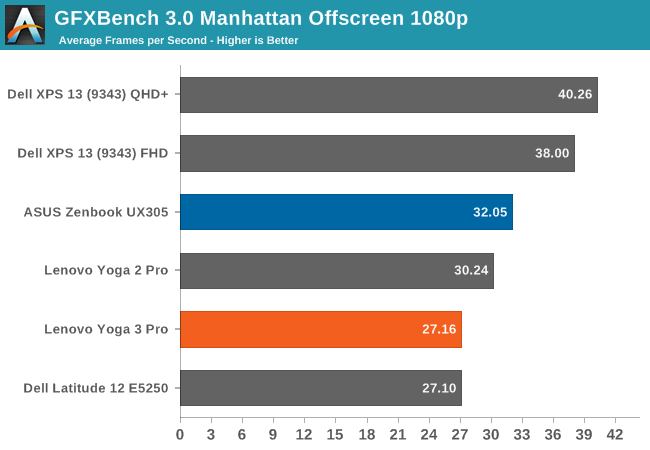
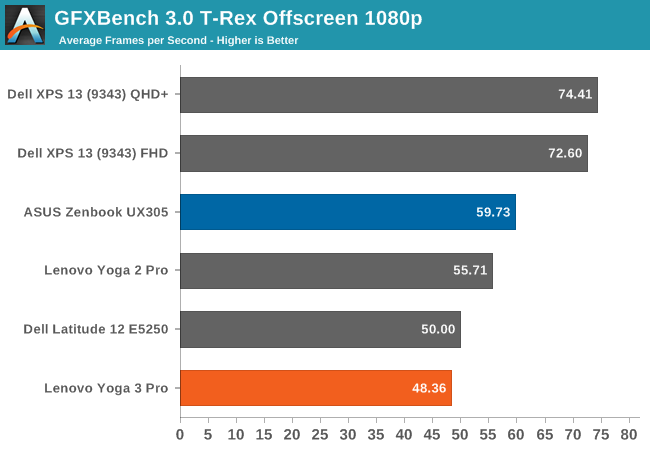
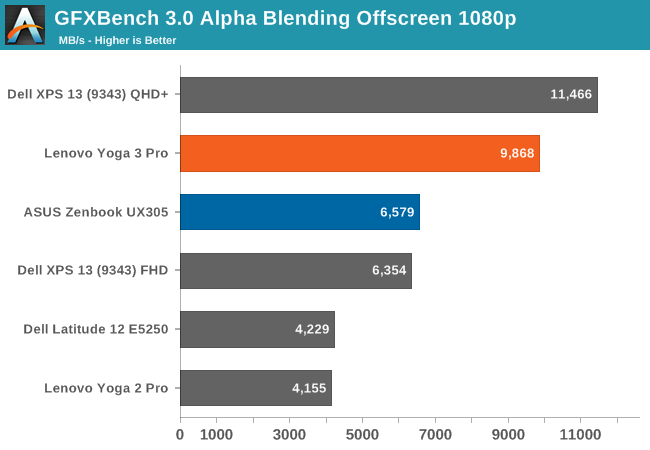
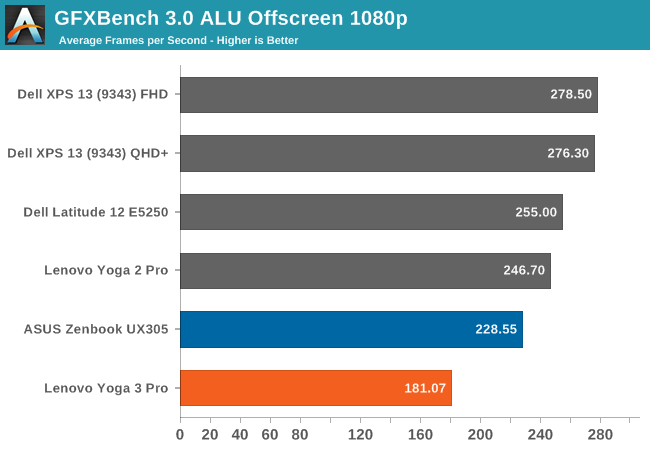
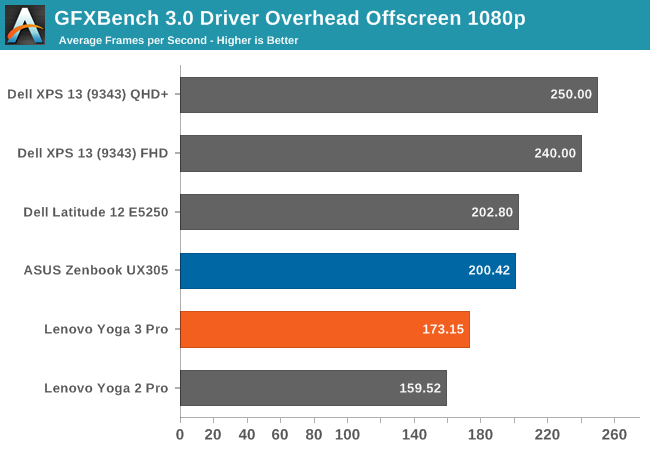
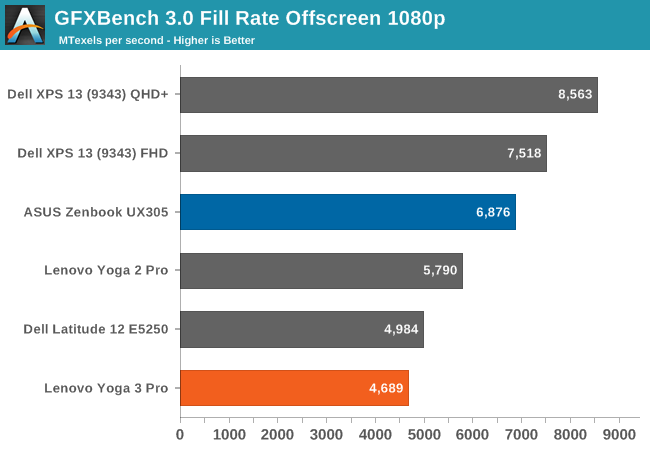
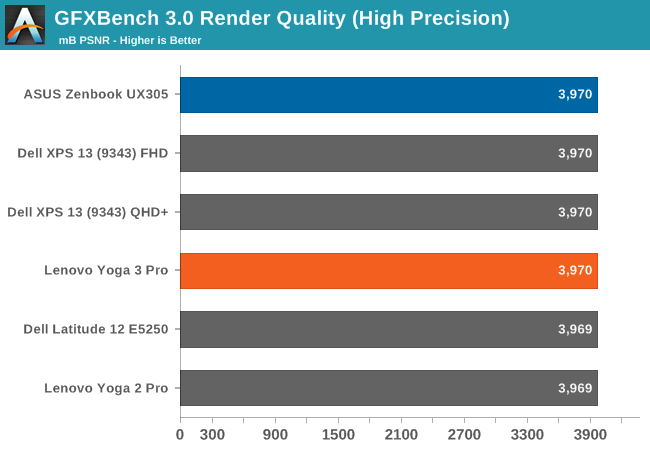
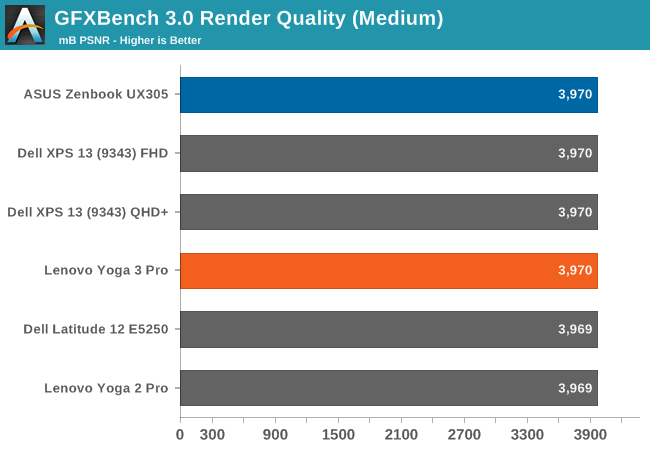
GFXBench 3.0 is available in the Windows Store, and is a DirectX version of GFXBench. On the two gaming benchmarks (Manhattan and T-Rex) we can see that the UX305 pulls ahead of both of the Haswell-U based devices in our graphs, which are the Yoga 2 Pro and the Latitude 12. The Dell XPS 13, with Broadwell-U, is still a lot more powerful which is not surprising since it has a 15 watt TDP compared to just 4.5 watts on Core M (Broadwell-Y). Once again, we can see that the ASUS is stronger than the Yoga 3 Pro.
DOTA 2 Benchmarks
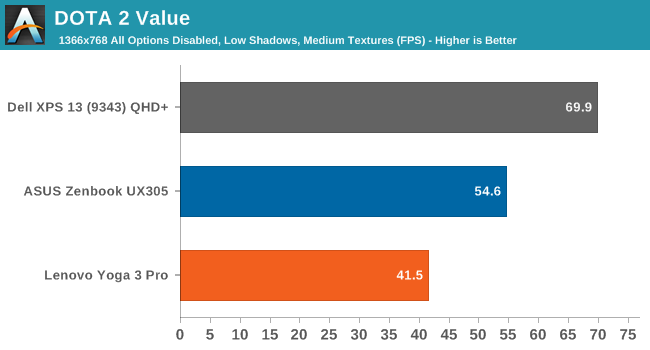
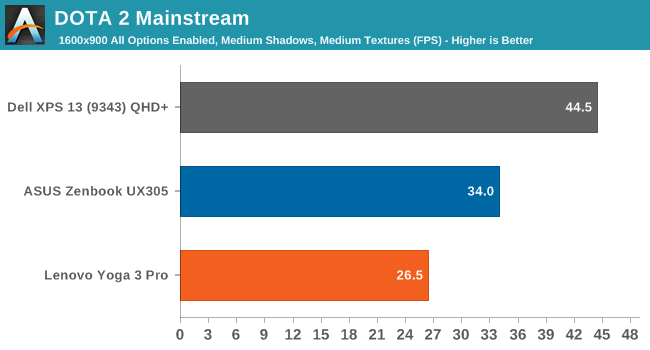
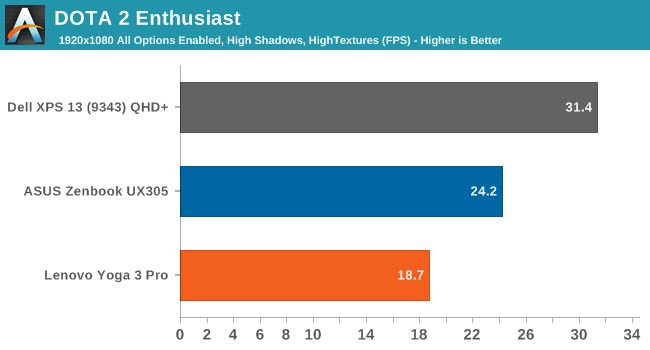
One area where the Yoga 3 Pro struggled was with our DOTA 2 benchmark, which is quite long in duration. We run at three different levels, and the Yoga 3 Pro fell quite far behind the Dell XPS 13. The ASUS UX305 closes that gap though, and gave a much higher frames per second than the Yoga 3 Pro.
Tablet Comparison
As with the Yoga 3 Pro, we will compare the ASUS UX305 to several tablets to see where Core M fits in the lineup. The UX305 is certainly not a tablet competitor unlike the Yoga 3 Pro, but the improved GPU performance seen in the laptop comparisons should give us some more information to about where the Intel graphics compare to the best SoC GPUs available today.
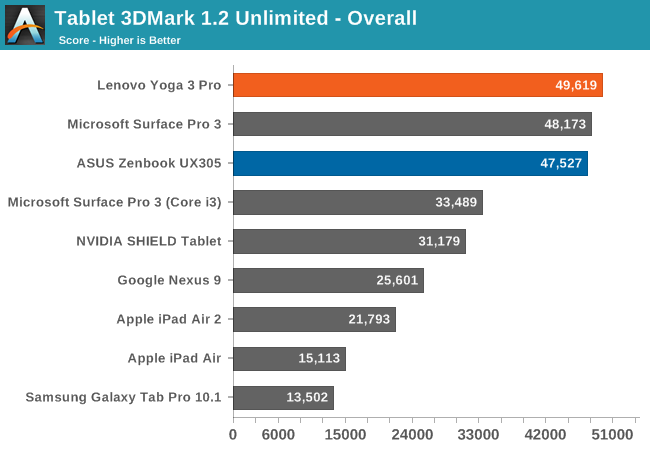
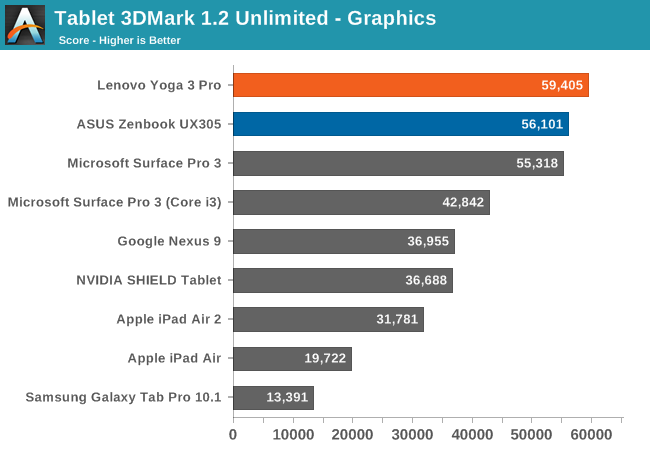

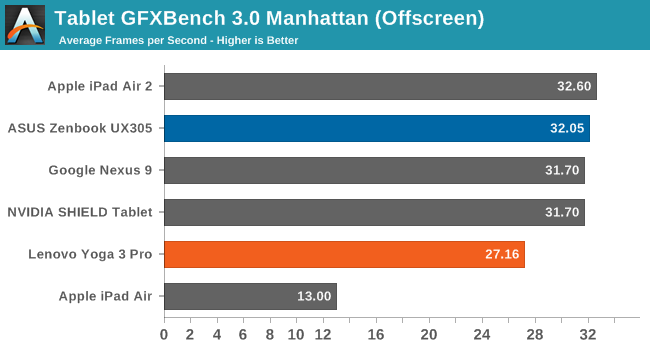
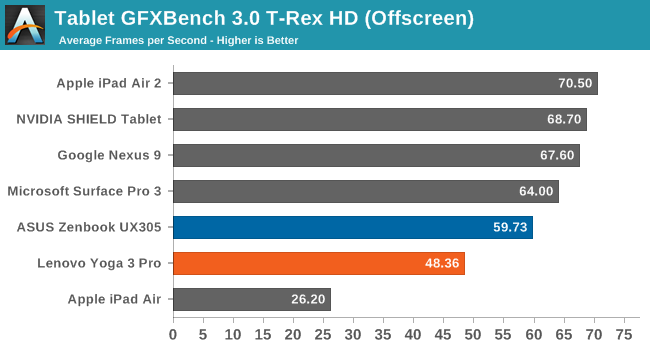


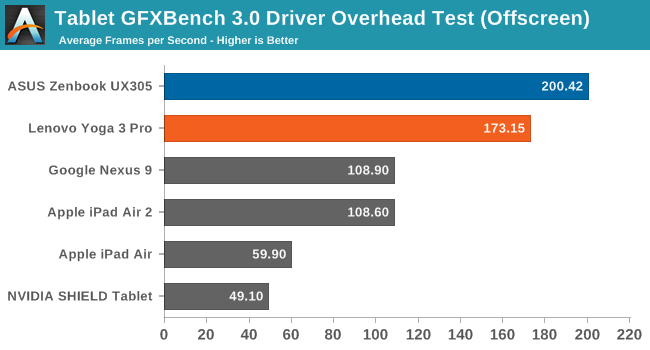
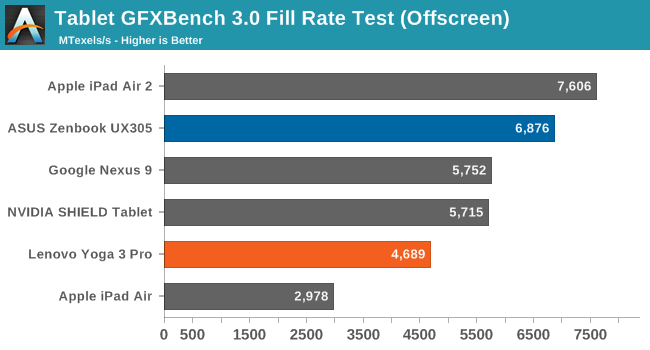
3DMark Unlimited shows the capabilities of the GPU, but is so short that the throttling issues we have observed do not come in to play. The Gen8 graphics of HD 5300 should certainly be able to compete favorably to any of the tablet SoCs if give enough headroom, however that is obviously not the case.
The GFXBench scores show that the Core M 5Y10 can compete with tablets, with it coming in very close to the same scores as all of the latest tablets on the Manhattan score. The T-Rex benchmark is much easier, and it falls behind a bit, but is still a lot quicker than the Yoga 3 Pro.
GPU Conclusion
The increased thermal headroom that ASUS allows on the UX305 has dramatically increased the GPU performance of Core M when compared to the Yoga 3 Pro. The device does get warm though, with it hitting close to 50°C at the top of the laptop, but it does not affect the keyboard or wrist areas. The lack of a fan makes these scores even more surprising, but Lenovo has opted to keep the surface temperatures a lot lower on the Yoga 3 Pro.
There is a lot to be said about Core M performance, and too much to put in this review. We will be doing a deeper dive into the performance of Core M and how it performs in various devices, both actively and passively cooled, as well as compared to Broadwell-U based systems which are a more traditional design. Clearly, there is a lot of factors that affect performance in a device such as this than just the label on the spec sheet.


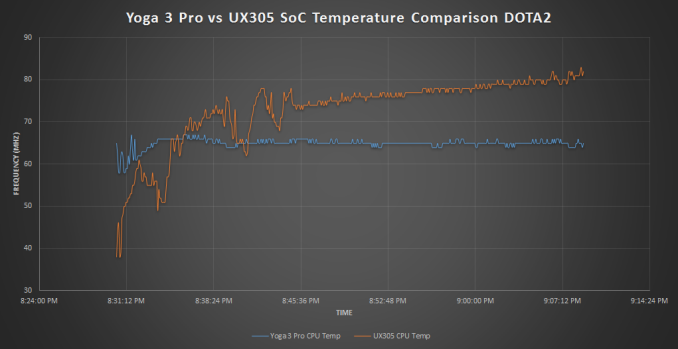








164 Comments
View All Comments
Klug4Pres - Wednesday, March 25, 2015 - link
I don't know why people want to buy these thin & light machines. What is wrong with a 5 lb laptop with a 35 Watt CPU, four RAM slots, two spindles, 14.1 inch 4:3 SXGA+ screen etc.? I keep being told "the ship has sailed", but I have no idea why.Novacius - Wednesday, March 25, 2015 - link
If you're traveling a lot or just have to take your laptop with you every day, you appreciate a lighter laptop. Very, very much. They also have much better battery life.Ian Cutress - Wednesday, March 25, 2015 - link
I used to carry a 4kg laptop with extended battery, 1200p screen etc to events like Computex and day trips/meetings for a couple of years. Put it this way, I'm glad I have a UX301 now at just over 2lbs. That being said, there are a few lighter weight systems that have me interested, like the LaVie Z that we saw at CES.Refuge - Wednesday, March 25, 2015 - link
I am the definition of a desktop replacement buyer.But even I see the relief in pulling out a 2lb feather on an airplane rather than some 17in 7lb beast.
Although those days are even coming to an end. Now you want a desktop replacement, the new Gigabyte P35X is a perfect idea! Thin, light, and TONS of horsepower. :)
Flunk - Wednesday, March 25, 2015 - link
If you want light and power I'd recommend getting a desktop AND a thin and light notebook. Why? The compromises necessary for thin and light notebooks are not compatible with the idea of a powerful notebook. Because of this you have to make a lot of compromises when it comes to heat, battery life, performance, price. At some point it might be possible but you can't get the best of both worlds right now.killeak - Wednesday, March 25, 2015 - link
Well, I disagree. As a render programmer that travels and works remote a lot (once every two months as minimum) I need a powerful laptop to work with. And the true is that these days there is plenty of great options that give you both (portability and performance). Recently I bought a Clevo p650sg (i7 4720hq, 980m, 32gb RAM, 2xSSD 500 + HD 1tb) for 2k usd. That being said, I do have a modern desktop PC at home that I bought last year (i7 4790, 16gb RAM, 500gb SSD + 2tb storage and a GeForce 770), but I prefer to use my laptop (I also bring it to the office and I plug to monitors and keyboard to increase my productivity). Performance wise, I will say that there is not much difference between my new laptop and the desktop that I use, in fact my new laptop is more powerful than my desktop at work except for the CPU (4770, 16gb RAM, 256 SSD and geforce 760).I love to have the performance of a powerful desktop in 2.6kg (before I had a Lenovo Y500, not that powerful but close and same weight). These days I use my desktop pc at home more as a media server and some occasional gaming on the TV than for work or main gaming platform (in any case I play SC2 and Civ5 mostly and I can play those on my laptop, even my old one).
That being said, I do see the point of ultrabook or hybrids. I also have an Asus T100 that I use as my true mobile laptop/tablet that I bring with me everywhere. For web surfing, mails, word/excel, watching movies/series at the airport/airplane, etc. is great, and battery life is awesome. I see myself buying a Surface Pro 4 or something like it in the future, to replace the T100, but not for actual work since I need a true i7 (not ULV), lot of ram and a powerful GPU, that I can bring with me when I travel.
Refuge - Wednesday, March 25, 2015 - link
I disagree, but only half.While you are correct and if you want power then there is no better solution than a full fledged desktop.
But you can't say that Laptops can't be defined as powerful when it is toting a 4ghz I7 with a GTX 980m. That is like saying a Corvette isn't sports car because it isn't a Ferrari. Laughable I know right?
Either way, broad stroke generalizations like that are quickly falling apart with each passing year as they cram more and more power into smaller and smaller packages. Anymore you are really only lacking in personal upradability. Which I can see being a big enough problem to turn people towards a desktop form factor of some sort.
andrewaggb - Wednesday, March 25, 2015 - link
I mostly agree, I've done the 17" laptop with dedicated graphics. It quickly lost it's ability to play the latest games with high settings, and eventually do play the latest with reasonable settings. It's battery life sucks, it's heavy, it's useless on an airplane, etc.It was handy for gaming on vacation though. I've been tempted to buy 2 new laptop's, another gaming/big screen 17" laptop and a 12 or 13" ultralight. They're both laptops, but they serve completely different purposes.
Conficio - Wednesday, March 25, 2015 - link
Working with two machines brings a lot of hassles of its own. Installing apps twice, upgrading twice, synching data, etc. having more storage on the desktop means you have to be selective and then you go the wrong selection on the road.I'd wish I could have an OS that has a seamless cloud extended storage, synching apps and documents a I need. Did I describe ChromeOS here?
kingpotnoodle - Wednesday, March 25, 2015 - link
Because (very obviously) if you don't need a powerful machine but you do a lot of travelling then it's much better to have a lighter machine with a long battery life. Most of my work is web/ssh/rdp, long battery life and lighter weight are FAR more important to me than it being able to play Crysis or do video editing lightning fast.